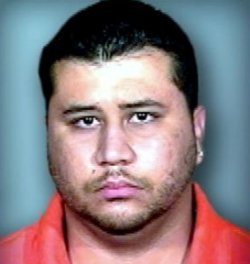
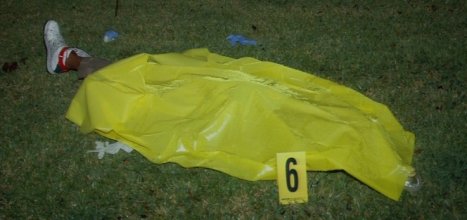
An Unnecessary Death
Shortly after 7:00 P.M. on Sunday, February 26, 2012, seventeen-year-old Trayvon Martin talked on his cellphone with his friend, Rachel Jeantel. He carried a bag of Skittles and an Arizona watermelon juice cooler as he headed along a sidewalk in the Retreat at Twin Lakes townhouse community in Sanford. When George Zimmerman, driving his SUV to Target for an errand, looked out his window he spotted Martin and concluded, as he told police in a phone call, he was "a real suspicious guy." What about Martin made him suspicious is not completely clear. What is known is that Martin was unknown to Zimmerman, young, wore a hooded sweatshirt, walked slowly in the rain--and, most central to the debates that would later ensue, was black. Asked later that night in a police interview the cause for his suspicion, Zimmerman said, "I've never seen him in the neighborhood. I know all the residents. It was raining out and he was leisurely walking, taking his time, looking at all the houses."
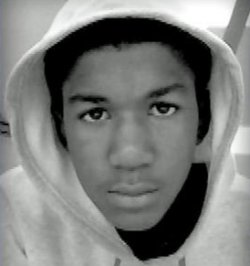
Trayvon Martin
Zimmerman called Sanford police at 7:09 to report his suspicions. He told the dispatcher that the man in "a grey hoodie" was "just walking around looking at all the houses" and "now he's staring at me." Telling the dispatcher "he's coming to check me out," Zimmerman asked, "How long until you can get an officer over here?" Told by the officer "we've got someone on the way," Zimmerman responded in frustration: "These assholes, they always get away."
Martin, meanwhile, was talking on his cellphone with a friend in Miami named Rachel Jeantel. He complained to Jeantel "that a man was watching him"--a man Martin described as "a creepy-ass cracka." Jeantel warned Martin that the man might be a rapist and urged him to run.
Zimmerman told the dispatcher, "Shit, he's running," and got over to his car to follow him. The dispatcher, sensing that Zimmerman was giving chase, asked, "Are you following him?" When Zimmerman replied, "Yeah," the dispatcher said, "Okay, we don't need you to do that." Zimmerman answered, "Okay." The dispatcher suggested that Zimmerman meet the arriving officer "near the mailboxes," and he said, "Yeah, that's fine." Seconds later, the four-minute call to the dispatcher ended. According to Zimmerman's police interview later that night, "I was walking back through to where my car was and he jumped out from the bushes and he said, 'What the fuck's your problem, homey?' And I said, 'I don't have a problem,' and he goes, 'Now you have a problem,' and he punched me in the nose." According to Zimmerman, the punch knocked him to the grass, where Martin continued to pummel him as "I started screaming for help. I couldn't see. I couldn't breathe."
Martin's friend, Rachel Jeantel would offer a somewhat different version of the encounter. According to Jeantel, Martin was still on the phone with her when he and Zimmerman came face to face. She reported that she "heard Trayvon say, 'Why are you following me for?' Then I heard a man, breathing hard, say, 'What are you doing here?'" She then heard a bump, which she assumed was Martin's headset falling to the ground. As she yelled, "Trayvon, Trayvon" she heard "wet grass sounds" and then "kind of heard" Trayvon saying, "Get off, get off" before the phone shut off.
In Zimmerman's retelling of the ensuing struggle to Officer Doris Singleton later that night, Martin "grabbed my head and started hitting it into the sidewalk." Zimmerman managed to pull himself back to the grass and yell, "Help me, help me. He's killing me." Martin, on top of him, responded by covering Zimmerman's mouth with his hand and telling him, "You're going to die tonight." At that point, as he tried to slide away, "my jacket and my shirt came up...and I felt his hand go down on my side and I thought he was going for my firearm. So I grabbed it immediately and as he banged my head again, I just pulled my firearm and shot him."
Zimmerman's version of events is largely consistent with the statement of eyewitness Jonathan Good, a resident of one of the townhouses close to the site of the fight, and the observer closest to the confrontation and considered by police to be its most reliable eyewitness. Hearing noise outside his residence, Goodr opened a sliding door to hear cries of "Help, help, help" and see a person wearing a dark sweatshirt on top of a person wearing a "lighter colored"--perhaps "red or white," he guessed (Zimmerman actually wore an orange zip-up sweatshirt)--"shirt or sweatshirt or whatever." Good told police, "The black guy was on top" and "the guy that was on the ground under him...was definitely a lighter color." As Good ran to call 9-1-1 he heard the sound of gunfire. When he looked outside again, Good saw "two gentlemen with flashlights asking what was going on and the one guy that was on the bottom said I shot the other guy in self-defense."
The bullet from Zimmerman's gun penetrated Martin's chest, fatally wounding him. Officer Timothy Smith arrived at the scene less than two minutes after the shooting to find Zimmerman standing near Martin, who was face down in the grass and unresponsive. Zimmerman told Smith he shot Martin in self-defense. Smith took Zimmerman's gun and handcuffed him, noting that he was bleeding from his nose and the back of the head and that the back of his jacket was wet and covered with grass. Zimmerman was taken to the Stanford police station where he was questioned for five hours, first by Officer Singleton and then by Detective Chris Serino. Martin's body was taken to the morgue, where it was tagged as "John Doe."
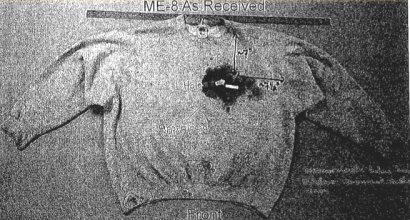
The Investigations
Tracy Martin, Trayvon's father, filed a Missing Persons report the next day. About 9:20 A.M., police officers arrived at his fiancee's condo, where Tracy Martin identified photos of his dead son.
In the first twenty-four hours after the shooting, in addition to subjecting Zimmerman to several hours of questioning, police photographed his injuries, collected gun residue from his hands, gave him a voice stress analysis to test the truthfulness of his assertions (he passed), and took him back to the scene of the shooting where performed a videotaped re-enactment of the incident. On March 12, Sanford Police Chief Bill Lee said, "Until we can establish probable cause to dispute [Zimmerman's claim of self-defense], we don't have the grounds to arrest him." Lee acknowledged the criticism his office had received over its handling of the investigation. "We are taking a beating over this," he said. "This is all very unsettling. I'm sure that if George Zimmerman had the chance to relive Sunday, February 26, he'd probably do things differently. I'm sure Trayvon would too."
With the Sanford police convinced that Zimmerman had a strong self-defense claim, that might have been the end of it, but for a persistent Tallahassee civil rights attorney named Benjamin Crump. When Tracy Martin asked Crump for help in prompting prosecution of Zimmerman, Crump took the case to the media. He held press conferences with Trayvon's parents in which they told of the suffering caused by the loss of their son, brought pressure for release of the 911 tapes (which helped turn the case into a national story), organized a series of rallies calling for justice for Trayvon, and convinced African-American leaders such as Jesse Jackson and Al Sharpton to take up the cause. By mid-March, the case was a fixture on cable news and a front page story around the country. It was a story--as reporters say of one with staying power--"with legs." For some commentators, the case was mainly about the evil of racial profiling, while others saw it as a demonstration of the risks of "Stand Your Ground" laws. A Change.org petition calling for Zimmerman's arrest collected 2.2 million signatures. Many celebrities and professional athletes, including Lebron James and the entire Miami Heat NBA team, donned hoodies to show their support for Martin. On May 23, President Obama weighed in, saying "If I had a son, he'd look like Trayvon Martin."
The national focus on the Zimmerman case pushed authorities in Florida into action. On March 22, Sanford police chief Bill Lee was placed on paid leave. The following day, State attorney Angela Corey, appointed by Florida Governor Rick Scott as a special prosecutor, began an independent review of the evidence with the assignment of determining whether the case warranted prosecution. The Justice Department also launched its own investigation into whether Martin's civil rights had been violated.
Interviews conducted by the FBI failed to produce substantial evidence that Zimmerman's actions were racially motivated. More likely, it seemed to Sanford lead police investigator Chris Serino, Zimmerman's initial decision to give chase was influenced by recent burglaries in the neighborhood, Martin's dress, and the circumstances of their encounter. He maintained that Zimmerman's story had factual support and there was insufficient evidence to file charges. Nonetheless, on April 11, even without taking the expected step of convening a grand jury to consider the matter, Angela Corey directly filed second-degree murder charges against Zimmerman. Several legal analysts, including Harvard law professor Alan Dershowitiz, criticized Corey's action, suggested that she over-charged, and that the evidence could not support a murder charge. Zimmerman turned himself in later that day to face charges in a trial that almost no one in law enforcement believed should happen. Following a bail hearing on April 20, Zimmerman was released on a $150,000 bond and fitted with an electronic monitoring device. (Weeks later, Zimmerman's bond was revoked and he was sent to jail after evidence surfaced that Zimmerman's wife had misrepresented the family's finances at the bond hearing. After a second bond hearing in July, a new bond was set at $1 million and Zimmerman was re-released.) Zimmerman's attorney entered a not guilty plea on his behalf.
Zimmerman was not without his supporters, however. A website he launched brought in tens of thousands of dollars for his defense. He presented his side of the story to sympathetic interviewers, such as Shawn Hannity of Fox News. (He told Hannity he would not do anything differently and what happened "was all God's plan." He also said, however, he wished he "wouldn't have been put in a position where he had to take a life" and that "I'm sorry that this happened. I'm truly sorry.") Zimmerman also brought a defamation suit against NBC News for editing his call to the Sanford police dispatcher in such a way as to make it appear he had engaged in racial profiling when, he insisted, he had done no such thing.
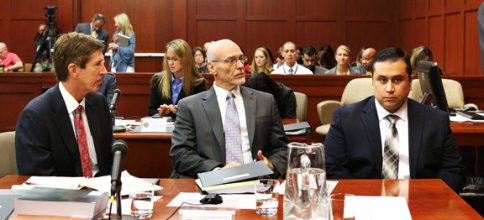
The Trial
Florida adopted a "Stand Your Ground" law that allowed a person who reasonably believed it necessary to use deadly force to prevent serious injury to himself to do so without retreating. The law also provided that a defendant claiming to have acted in self-defense to seek a pretrial immunity hearing in which, if the defendant could show by "a preponderance of the evidence" that he or she acted lawfully, would result in an order from the court granting the defendant immunity from prosecution. In August 2012, Zimmerman's attorney, Mark O'Mara, announced that his client would ask for immunity hearing under the "Stand Your Ground" law. No such hearing would ever take place, however. On further consideration, Zimmerman waived his right to an immunity hearing. O'Mara later explained that he concluded the Stand Your Ground law didn't apply because his client had no option to retreat. He also noted that the hearing would force him to reveal his case to the prosecution in advance of the trial, if the judge were to deny Zimmerman's immunity petition.
Judge Debra Nelson issued several rulings on pretrial motions on May 28, 2013. She ruled against allowing evidence related to Martin's prior fights, marijuana use, and familiarity with guns. She also denied a request by the defense to take the jury to the crime scene. Finally, noting the tense circumstances surrounding the trial, Judge Nelson ruled that the jury would remain anonymous and be referred to by numbers only.
On June 20, ten days after completing jury questionnaires, a six-person, all-female jury was selected for the trial. Five of the selected jurors were white, while one was mixed race, but considered herself Hispanic. The defense struck a potential juror who failed to reveal that her pastor had advocated strongly for Martin. The prosecution struck an African-American gun-owner who was a fan of Fox News.
In a thirty-minute opening statement on June 24, Prosecutor John Guy began, in a manner that startled and put off at least one juror, by quoting a remark made by George Zimmerman in his call to the Sanford police dispatcher: "Funking punks, these assholes always get away." Guy told the jury that the evidence would show Zimmerman suffered no serious injury in the fight and that he was a liar and a "wannabe cop" who concluded, with little evidence to support it, that Martin was "someone about to commit a crime in his neighborhood." Don West began the opening argument for the defense in a way different from, but no less memorable, than the prosecution's opening line: he told a knock-knock joke that left most courtroom observers scratching their heads. West said, "Knock knock!/ Who's there?/ George Zimmerman./ George Zimmerman who?/ All right, good, you're on the jury." No one laughed and West promised "no more bad jokes." Turning to the evidence, West told the jury he would show Martin "sucker punched" his client and "had his head hammered against the ground." He played for the jury Zimmerman's call to the police dispatcher and said Martin had an opportunity to head home but instead decided to confront Zimmerman. He contended the forensic evidence would prove Zimmerman shot Martin from below, with Martin's shirt hanging down over his client's prone body.
The Prosecution Case
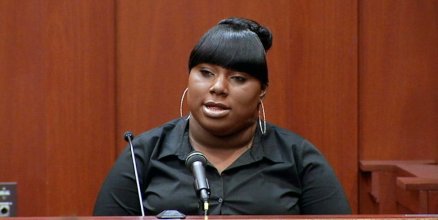
The prosecution had the burden of convincing the jury, beyond a reasonable doubt, that George Zimmerman could not reasonably have believed that is was necessary to use deadly force to save himself from serious bodily harm at the hands of Trayvon Martin. Under the facts of the case, and the doubts concerning them, every astute observer knew that to be a difficult--possibly impossible--task.
The prosecution's first witness, fifteen-year-old Chad Martin, the son of Trayvon's dad's fiancee, testified that he had sent Trayvon on a mission to the neighborhood 7-Eleven to buy him a bag of Skittles, which Martin did while Chad continued to play a Play Station 3 video game in his mother's townhouse. Trayvon, the prosecution hoped to suggest through Chad's testimony and that of the 7-Eleven clerk who Martin paid with cash, was doing nothing that Sunday night that warranted Zimmerman's suspicion. Sean Noffke, the Sanford PD dispatcher called by Zimmerman and the state's first witness to address the fatal incident itself, testified that he told Zimmerman, "We don't need you to do that [follow Martin]." Noffke characterized his words as a suggestion for the safety of the caller, not an order--explaining that dispatchers are instructed not to give orders for liability reasons. On cross-examination, Noffke said that he considered Zimmerman's reference to Martin's race to be for purposes of identification of the suspect and not at all unusual.
Officer Ricardo Ayala testified that when he arrived at the Retreat at Twin Lakes within minutes of the shooting he found Officer Timothy Smith holding Zimmerman at gunpoint. He testified he approached Martin, not knowing whether he was alive or not with his body face down in the grass, and said "show me your hands." Not getting any response or seeing any motion, he turned Martin's body over and attempted to perform CPR, to no avail. On cross-examination, Ayala testified that Zimmerman was not confrontational and complied with all requests. Officer Smith, the first officer on the scene, testified that Zimmerman's back was wet with grass, that he had a bloody, swollen nose, contusions and lacerations, and that he had cuts on the back of the head. Smith said Zimmerman told him "he was yelling for help and no one would come help him." Zimmerman, he testified, complained about feeling "lightheaded," but refused an offer to be taken to the hospital.
Officer Doris Singleton interviewed Zimmerman at the Sanford police station on the night of the shooting. She testified that Zimmerman told her that Twin Lakes had been the scene of a series of recent burglaries and that he started a neighborhood watch program. Zimmerman told her, she said, that Martin was suspicious because he was strolling leisurely in the rain, looking at all the houses. He emphasized that he knew "all the residents" and had never before seen this teenager in the neighborhood. Singleton said that Zimmerman's suspicions were further aroused when Martin circled his car as he was on the phone inside the car talking by cellphone with a police dispatcher. To a large extent, Singleton proved a more valuable witness for the defense than the prosecution, providing the jury with Zimmerman's version of events, including Martin's jumping out from the bushes, punching him in the face, and banging his head on the concrete sidewalk. She further bolstered the defense case by testifying that never, during her interview with him, did Zimmerman appear angry or spiteful towards Martin.
The prosecution's final police witness, Detective Christopher Serino, the lead investigator on the case, also seemed to provide more support for the defense than the state. Recordings of Serino's interview with Zimmerman, as well as Zimmerman's videotaped re-enactment of the incident for Serino the following day, offered additional opportunities for the jurors to see events through the defendant's eyes. He did, however, concede that Zimmerman's words "these fucking punks" indicated a degree of hostility and spite, and testified there was evidence suggesting Zimmerman might have continued to follow Martin after being told not to, and that he might have exaggerated the number of times he was hit by Martin. Those questions about his story, however, did not lead Serino to think that Zimmerman was being evasive or "cagey." Asked on cross-examination whether he thought Zimmerman was telling the truth, Serino said "yes." (The prosecution objected to the defense question about Serino's assessment of the defendant's truthfulness, and Judge Nelson instructed the jury to ignore Serino's answer, but damage to the state's case was already likely done.)
One of the central issues in the case was whose voice was it that was crying out for help on that dark and rainy night. In the end, the defense would have the better of that argument. All the prosecution could do was offer the testimony of a voice analysis expert, Hirotaka Nakasone, who told the jury, essentially, "it's hard to tell." Nakasone testified that out of the 45 seconds of recording on a 9-1-1 call between the first scream for help and the gunshot, only 3.5 seconds could be isolated for voice analysis and that was not an amount "fit for the purpose of voice comparison." He added that the the same word repeated over and over ("Help!") makes voice recognition more difficult than if the speaker used a variety of words, and that trying to estimate the age of the speaker by listening to screams in a "life-threatening" situation was "very, very challenging."
Several residents of the Retreat at Twin Lakes development presented some of the most important prosecution testimony in the case, but--once again--most of it seemed to help rather than hurt Zimmerman's defense. Selene Bahadoor told jurors that when she heard noises outside her townhouse she went to her sliding glass door and saw "figures and arms flailing." Bahadoor said she went to her kitchen to turn off the stove, heard a gunshot, and returned to her door to see someone lying face down in the grass. To the extent that anything in her account helped the state's case (possibly that the initial flailing was between two vertical people), it was somewhat undercut by her admission on cross-examination that she had "liked" the Trayvon4Justice Facebook page. Jayne Surdyka opened her window when she heard an "angry, very agitated" voice. She saw two figures on the ground, one on top of the other, and heard a cry for help coming from, she thought, "the boy," because of its higher pitch. Jeannee Manalo also saw two figures on the grass, and guessed that Zimmerman might have been on top, but only because she thought the larger figure was straddling the smaller figure and subsequent news stories convinced her that Zimmerman was the larger person. The most compelling eyewitness testimony came from Jonathan Good, who lived in a townhouse very near the confrontation and had the best view of the incident. When Good looked out his door and saw "some sort of tussle" on the ground, he yelled "What's going on?" and "Stop it!" Good said the person on top wore a "dark" shirt or sweatshirt and that the person underneath wore a lighter color top--either "red" or "white" he guessed. (Zimmerman wore an orange top.) He also described the person being straddled as having the lighter colored-skin. He testified that he saw "multiple" downward thrusts of an arm from the person on top that "looked like punches" and heard the person on the bottom cry for help. When he turned to go inside his townhouse and call 9-1-1, the gunshot rang out in the night. Shown photographs of both Zimmerman and Martin, Good identified Martin as the person on top and Zimmerman as the person on the bottom. He also aided the defense by stating that in his opinion it was Zimmerman's voice screaming for help.
Rachel Jeantel was widely expected to be the prosecution's star witness. Allegedly on the phone with Trayvon Martin for a period of over twenty minutes leading to the fatal shot, nineteen-year-old Jeantel could tell the story from something resembling Trayvon's point of view. Unfortunately for the prosecution, Jeantel seemed ill-prepared for her testimony and spoke in diction that jurors found hard to understand. Judge Nelson had to repeatedly admonish Jeantel to speak up or slow down. Some observers speculated that Jeantel's speech patterns caused jurors to attach less credibility to what she had to say. Jeantel testified that Martin told her that he was being followed by a "creepy-ass cracka" and later in the phone call complained that "the nigga is still following me." (The latter label left many in the courtroom confused, possibly including prosecutor Bernie de la Rionda, who asked "Forgive me--nigger? The N word?" Jeantel offered that the label was just "slang," but not given the chance to explain further why it might apply to Zimmerman.) One juror would say after the trial that several other jurors found Jeantel's use of the word "cracka" offensive and used that as an excuse for discounting her testimony. The thrust of Jeantel's testimony was that Martin feared Zimmerman and was trying to get away from him, and not that he was looking for an opportunity to ambush him. Jeantel also testified that she thought it was Trayvon's voice calling for help on the 9-1-1 recording. After less than an hour of direct examination, Jeantel endured five hours of sometimes withering cross-examination from defense attorney Don West. She was forced to admit on cross that she'd lied to avoid going to Trayvon's funeral, lied about her age when first contacted concerning the case, and at various times had offered several different accounts of what happened. The tough questioning made Jeantel hostile and even caused her to say she was leaving at the end of the day and not returning to the witness stand. She did return, but when all was said and done, the state's star witness had been neutralized.
(In 2019, investigative journalist and documentary film make Joel Gilbert, concluded that Jeantel was not actually the girlfriend on the phone with Trayvon just before he was killed. Rather, Gilbert suggests compellingly in his documentary, it was actually Jeantel's half-sister, Brittany Diamond Eugene who was on the call, but Ms. Eugene refused to testify against Zimmerman. Gilbert alleges that attorney Benjamin Crump substituted Jeantel for Eugene as the witness who would supposedly destroy Zimmerman's defense. On the strength of Gilbert's claims, George Zimmerman filed, in December 2019, a $100 million lawsuitt against Crump, Trayvon's parents, and Jeantel. Gilbert's evidence for the fraud consisted of a detailed analysis of 750 pages of Trayvon's phone records, DNA testing, handwriting analysis, and--ultimately--an interview with Eugene.)
The Defense Case
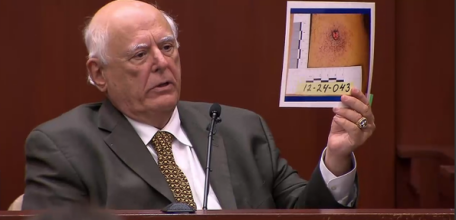
The defense needed to show that Zimmerman had a reasonable fear of serious injury before he pulled the trigger--or at least to convince a jury that he might have had a reasonable fear of serious injury. This they would do, primarily, through testimony that it was Zimmerman's voice crying for help that was heard on 9-1-1 recordings and that he, and not Martin, was on the bottom when the fatal shot was fired. Although not essential to the defense strategy, the defense also wanted to suggest that Zimmerman had reason to think Martin might have been, as he told a police dispatcher before the shooting, "up to no good."
In an effort to explain why Zimmerman might have had reasonable suspicions about Martin, the defense introduced testimony about crime at Twin Lakes. Olivia Bertalan, a twenty-one-year old resident of the development, testified about a terrifying incident that occurred several months before the Martin shooting. Bertalan was home alone with her infant son when a man rang her doorbell. As she peered out the door, not recognizing the man, a second man entered her home through a backdoor. She ran upstairs, called 9-1-1, and locked herself in a bedroom as her house was burglarized. At one point, the burglar tried to turn the knob of the door where they hid. Bertalan testified that after the burglary, Zimmerman cam to her townhouse and gave her a lock for a sliding glass door, told her she was welcome to spend time with his wife whenever she was afraid. She guessed that she discussed the incident at least twenty times with Zimmerman.
Adam Pollock, the owner of a kickboxing gym where Zimmerman worked out, was called to the stand to suggest it was most likely Martin, not Zimmerman, who had most to fear in a fight. Pollock testified that Zimmerman was unathletic and "grossly obese." Pollock told jurors Zimmerman was "a very pleasant, very nice man" who was "physically soft" with "not a lot of muscle" and "not a lot of strength."
Dennis Root, a former police officer and self-defense and use-of-force expert, expressed his opinion that the forty seconds of fighting heard on 9-1-1 calls was "a very long time to be involved in any physical altercation"--long enough to produce high levels of fear and anxiety and a need to consider "changing tactics, because the tactics you are using are not working." Obviously, the defense hoped Root would help convince jurors that Zimmerman was not unreasonable in reaching for his gun.
Many courtroom observers believe that the testimony of forensic pathologist Dr. Vincent Di Maio greatly strengthened the defense case. Di Maio testified that his analysis revealed that the gun was touching Martin's sweatshirt and was "two to four inches" from Martin's body when the fatal bullet was fired. This, Di Maio said, is consistent with Zimmerman's story that he was on the bottom and Martin on top straddling him, because in that position the sweatshirt would be hanging down from Martin's body a few inches. "The medical evidence is consistent with [Zimmerman's] statement," Di Maio concluded. Di Maio also described Zimmerman's head lacerations, temple wounds, and bloodied nose as "consistent with" having had his head banged into a sidewalk and being punched in the nose, as Zimmerman claimed had happened. Di Maio also expressed his opinion that Trayvon Martin was probably conscious for about 10 to 15 seconds after being shot.
Finally, the defense offered a parade of witnesses to drive home, they hoped, a single point: that it was Zimmerman, not Martin, who cried for help in the night. Beginning with Gladys Zimmerman, George's mother, the jury heard witness after witness tell them it was Zimmerman's voice on the 9-1-1 recording. Gladys Zimmerman testified, after listening to the recording, "That's my son, George. That was he is screaming, it describes to me anguish, fear. I would say terror." Zimmerman's uncle, Jorge Meza, a former U.S. Army sergeant major, also was sure it was George's voice on the call. He testified that he instantly "recognized it was George screaming for help. That voice just came and hit me...I felt it inside my heart. I said, 'That's George.'" Several of Zimmerman's close friends agreed it was George's voice. Sandra Osterman said, "Yes, definitely, it's Georgie, I hear it, I hear him screaming." John Donnelly told jurors, "I know his voice, I know what his his voice sounds like when he gets excited or loud....There is absolutely no doubt in my mind that it is George Zimmerman and I wish to God that I didn't have the ability to understand that." Geri Russo, a former co-worker of Zimmerman testified, " I recognize his voice. I've heard him speak many times; I have no doubt in my mind that its his voice." Not content with only offering evidence that the voice was Zimmerman's, the defense called two police officers to suggest that the Martin family believed that the voice was not Trayvon's. Detective and lead investigator Chris Serino testified that when Martin's father, Tracy Martin, listened to the 9-1-1 call he became "emotional" and said that the voice did not sound like his son's. Officer Doris Singleton, also present when Tracy Martin listened to the recording, said that after the recording was played, Martin "was very upset, he was very sad, he hung his head and cried." Singleton testified, 'I don't know his exact words, but Tracy Martin was telling Chris it was not his son's voice." (Tracy Martin, in his testimony, said he told Serino, "I can't tell" whether it was his son's voice, but later decided he was sure it was Trayvon crying out.)
Closing Arguments, Deliberations, and Verdict
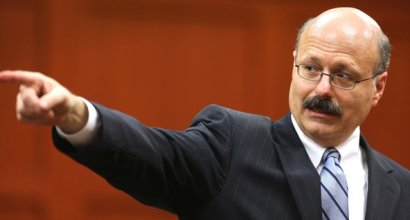
Attorneys offered closing arguments on Friday, July 12. Prosecutor Bernie de la Rionda told jurors that Zimmerman was a lying wannabe cop who jumped to the unreasonable conclusion that Martin was a criminal. Because of Zimmerman, "a teenager is dead through no fault of his own." Defense Attorney Mark O'Mara argued that Zimmerman was "not guilty of anything but protecting his own life." Holding up a chunk of concrete for the jury, O'Mara said Martin was not an innocent unarmed teenager. Under the law, jurors must, O'Mara insisted, give "the benefit of the doubt" to Zimmerman. Prosecutor John Guy had the final word. He asked jurors "to look into the heart" of Zimmerman and remember that if he had done what he should have done--stay in his car and wait for the police to arrive--Trayvon Martin would still be alive. "This case is not about Standing Your Ground," Guy argued, "it's about staying in your car." (However, as many observers pointed out, getting out of your car--even getting out of your car to follow someone you unreasonably think might be a criminal--is not a crime, however foolish it might be.)
After Judge Nelson offered instructions on what the jury must find in order to return a verdict either of second-degree murder or (the lesser included charge of) manslaughter, the jury commenced its deliberations. According to later statements by two members of the jury, the jury was initially split. At least three jurors were firmly convinced that Zimmerman was not guilty of either murder or manslaughter, while the other three preferred to find him guilty on at least one of the two charges. The jurors supporting the not guilty verdict proved to be the more persuasive, arguing that whether or not Zimmerman profiled Martin, or was foolish in following him, was legally irrelevant to the charges. As the deliberations progressed, the jurors initially inclined to find Zimmerman guilty came around to the view that "the law says at the end of the day all that mattered is who was on top on who was on the bottom"--and the evidence suggested Martin was on top and Zimmerman on the bottom (or, at the very least, there was a reasonable basis for believing that to be the case). After sixteen hours of debating the evidence, the jury returned its verdict of "not guilty."
In an interview with CNN's Anderson Cooper three days after the trial ended, a juror identified only as "Juror B37" offered her view of the case. She described George Zimmerman as "a man whose heart was in the right place, but went above and beyond what he really should have done." She added, "If anything, Zimmerman was guilty of not using good judgment...When he was in the car, and he had called 911, he shouldn't have gotten out of that car." None of the jurors, she told Anderson, "thought race played a role. We never had that discussion." In her analysis of the evidence, "Trayvon decided that he wasn't going to let him scare him ... and I think Trayvon got mad and attacked him." Citing Florida law, Juror B37 concluded Zimmerman "had a right to defend himself. If he felt threatened that his life was going to be taken away from him, or he was going to have bodily harm, he had a right." Stating the obvious, she said, "It's a tragedy this happened. But it happened."
Reaction to the jury's verdict varied. Civil rights leader Jesse Jackson said he was "stunned" by the verdict and Al Sharpton called it a "slap in the face of the American people." Tracy Martin described himself as "broken hearted" and Trayvon's mother said, "Lord, during my darkest hour I lean on you...I will love you forever Trayvon." President Obama said "the jury has spoken" and asked for prayers for two parents who lost their son. Former President Carter said the jury made the "right decision." Former NBA star Charles Barkley also thought the jury got it right. Among members of the public, reaction to the verdict split both along party and racial lines. In a Washington Post-ABC News poll, only 30% of Democrats, but 83% of Republicans approved of the jury's verdict. In another poll, almost 90% of African-Americans called the shooting unjustified, while only 33% of whites felt the same way.
Did the Prosecutors Have a Chance?
Several commentators described the efforts of the prosecution as "half-hearted" or even downright "incompetent." Lisa Bloom, in her book about the trial called Suspicion Nation: The Inside Story of the Trayvon Martin Injustice and Why We Continue to Repeat It, argued that the Zimmerman case was winnable and that the prosecution failed miserably. She faults the prosecution for not challenging more forcibly Zimmerman's assertion that he fired the fatal shot when he thought Martin was reaching for the gun strapped behind his back. Assuming Martin was on top and Zimmerman lying supine on the ground, Bloom suggests that it would have required "x-ray vision" for Martin to see a gun holstered behind Zimmerman, and that the prosecutors should have made a big deal of this fact, bringing into question the credibility of the rest of the defendant's story. Zimmerman's account, however, is more plausible than Bloom thinks. He told police on the night of the shooting that he thought Martin saw the gun when he slid, trying to squirm away, and "my jacket and my shirt came up." If Zimmerman had turned at an angle to Martin, even for a moment, and his shirt came up, then it is certainly plausible (even on a dark night) that Martin might have glimpsed the gun. More significantly, even if Martin did not see the gun, but Zimmerman--in the heat and anxiety of the fight--thought he did, that in itself would clearly support his self-defense claim. (In fact, what Zimmerman said was "I thought he was going for my firearm," which is much more difficult to establish as false than the assertion "He saw my gun.")
Bloom has other criticisms of the prosecution as well. She contends that Zimmerman became suspicious of Trayvon because he was black and that the prosecution erred by attempting "to stay a million miles away" from the "race issue." Instead of criticism, the prosecution deserves praise for not injected the hot-button issue of race into a case which, by almost any measure other than the fact that defendant was white and the victim was black, had little to do with race. The ultimate question for the jury to decide was whether Zimmerman reasonably feared death or serious injury at the hands of Martin, and how the two came to a confrontation in the first place is largely irrelevant to that issue. And even if it was somehow relevant, there certainly is a strong argument to be made that Zimmerman's suspicions arose primarily because Martin was not a resident of the Twin Lakes development (Zimmerman claimed to know all the residents), was a teenager wearing a hoodie when teenagers had been implicated in recent crimes at Twin Lakes, and was talking a stroll at what seemed to be an unlikely time--a dark and rainy night.
In the end, what most critics of the Zimmerman verdict seem to believe it should be a crime to be suspicious of someone because of his race, or that it should be a crime to follow a person when a police dispatcher says not to, or that it should be a crime to use deadly force against another unless one is facing something close to certain death. Yet none of those actions constitute crimes under Florida's--or any other state's--laws. Zimmerman might have allowed race to influence his suspicions, he probably should have stayed in his car and waited for police, and quite possibly he could have survived his fight with Martin. All that really matters, however, is that Zimmerman--who for forty seconds endured punches to the head and head slams into a concrete sidewalk and who found himself straddled by an attacker who might well have told him, (we'll never know whether Zimmerman's assertion here is accurate) "You're going to die tonight," had a reasonable belief that deadly force was necessary to save himself from serious injury. Moreover, unless the jury concluded beyond a reasonable doubt that Zimmerman lacked a reasonable belief that deadly force was necessary, they still owed him an acquittal.
This was not a winnable case--at least not winnable with any jury that looked at the evidence through clear eyes. State Attorney Angela Corey filed charges against Zimmerman under heavy political pressure to do so. But political pressure should not decide who gets charged with a crime and who does not. The facts of a case should decide that. The job of prosecutors is not to secure convictions; the job of prosecutors is to do justice, even when that means not prosecuting someone that most people think deserves punishment. In this case, in a charitable view of the facts, prosecutors might have decided to simply present evidence of Zimmerman's guilt and let the jury make a decision as a way of taking pressure off of their office. But when police and prosecutors do not themselves believe a defendant is guilty beyond a reasonable doubt is it ethical for them to try to convince a jury that the evidence supports that conclusion? The Zimmerman trial is a trial that never should have happened.
On February 24, 2015, the Justice Department, after interviewing 75 witnesses, closed its investigation into the Trayvon Martin killing without filing any federal charges.
In 2016, George Zimmerman announced his intention to auction off the Kel-Tec .9-mm pistol that he used to kill Trayvon Martin. “I am honored and humbled to announce the sale of an American Firearm Icon,” Zimmerman wrote in his online description. "This is a piece of American History.” Zimmerman said a portion of the proceeds will go to help fight Black Lives Matter “violence against law enforcement officers.” The Trayvon Martin Foundation, asked for comment on Zimmerman's decision to sell the gun said, “The Trayvon Martin Foundation is committed to its mission of ending senseless gun violence in the United States.” Beyond that, the group said, "The foundation has no comment on the actions of that person.”
